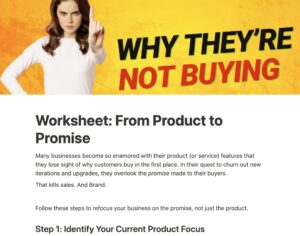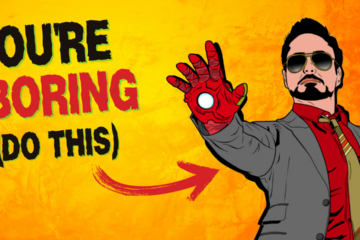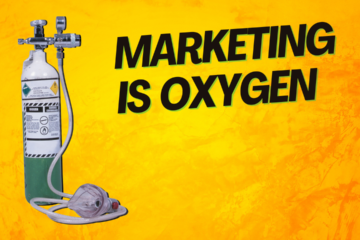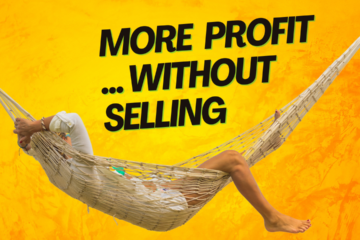Your Product Will Change, But Your Promise Should Not
Falling in love can cause you to make poor choices. That goes for business, too.
Many businesses become so enamored with their product (or service) features that they lose sight of why customers buy in the first place. In their quest to churn out new iterations and upgrades, they overlook the promise made to their buyers.
This product-centered approach is short-sighted, and we’re going to go over why (and what to do). Read on to see why you must shift to a promise-driven approach to strengthen your bond with consumers and secure their allegiance for a lifetime.
Make a Promise, Not Just a Product
Savvy businesses build their brand around a promise—a pledge of value they make to customers. This promise transcends any individual product.
Let’s look at some examples:
Southwest Airlines promises friendly, reliable, and affordable air travel. They don’t define themselves by the specific planes they fly.
Apple promises convenience, style, and thinking differently. Their brand retains its cachet even as they roll out products that might not always be on the bleeding-edge specifications-wise.
Starbucks promises a welcoming “third place” between work and home. Their brand retains its allure whether they’re selling coffee, tea, food, or merchandise.
In each case, the company makes a pledge to customers that goes beyond products. When you think Starbucks you do think coffee, but you think more than that. You think about the experience of Starbucks. That’s brand. And that’s built through a promise.
This promise becomes a competitive advantage.
The Product is Transient—The Promise is Forever
No matter how much they’re loved, products have a finite lifespan. I loved my 1st gen iPod, but it’s a brick.
Look at Kodak—once a titan of photography brought low by digital disruption.
Or Blockbuster, which thought its brick-and-mortar stores would always bring in customers.
But a company’s promise need never expire or go obsolete. Southwest still delivers a great flight experience, even though air travel has been transformed since the 1970s. If they keep their promise, they’ll be doing it in an era of space travel.
Apple and Starbucks still embody their core promises, even as they’ve rolled out thousands of new products.
Their promises give them flexibility to adapt with the times. They’re not tied to a bright blue candy-looking iMac or a Chocolate Black Tea Frappuccino with Earl Grey Jelly (I have no idea what that is but Starbucks used to offer it).
As long as they continue to fulfill their pledge to customers, they have permission to retire old products and try new ones.
Fulfilling the Promise Builds Real Loyalty
Promises create an emotional bond that products alone cannot achieve. And that bond begets loyalty.
Consider Peloton—they struggled to fulfill demand for their bikes and treadmills during the pandemic. Shortages forced people to wait months for their pricey equipment.
Yet few customers jumped to competitors. They were bought into the Peloton promise of an engaging, community-oriented fitness experience. Owning the gear was secondary. Peloton’s promise earned loyalty beyond any one product.
Companies earn this loyalty when the promise guides all their actions:
- Product design considers how to best fulfill the promise
- Marketing communicates the promise
- Support is ready to assist if the promise falls short
- Staff embrace their role in keeping the promise
The promise acts as True North for every customer touchpoint. Every decision made through the lens of that promise, because today’s product is just a means to an and.
If you’re a services business, it’s the same thing. Stop thinking in terms of “what I do for the customer” but “what is the bigger reason for customers to come to my business for their entire lives”?
Lead With Outcomes, Not Outputs
An old saying goes: “People don’t buy drills, they buy holes.” Customers are not moved by technical specs and features. They buy solutions to problems and desires.
The promise articulates the outcome a customer seeks. Features and technical details are outputs in service of that outcome.
Peloton shoppers don’t analyze metrics like resistance levels and video quality. They want the outcome of an engaging fitness experience. So Peloton emphasizes the promise in its marketing, not the specs.
Outcome-focused promises are also agile. The outputs can change with the times while the promise remains constant.
Southwest doesn’t define its brand by legroom inches and 737 models. The promise of friendly, reliable, and affordable air travel accommodates new planes and configurations.
Pinpoint the Desire, Then Build the Solution
Many entrepreneurs are so passionate about their product or service they put the cart before the horse. They start with the output then seek a market.
But when the product is the focus, it’s too easy to get lost in the weeds of features. You geek out with the tiny fraction of the customer base who cares about the stats rather than the purpose.
The promise-driven approach brings discipline. First pinpoint an unmet customer desire. Dig deep into the jobs they want done and the outcomes they seek.
Only then develop products purpose-built to fulfill that promise. Your passion should be for the customer, not the output. Build what they need, not just what you want to make.
The promise-driven approach is built around continuity. While products come and go, the pledge to customers remains steady. This is True North.
Fulfilling a promise earns loyalty beyond individual products. And focusing first on customer desires, not outputs, ensures your solutions are necessary and useful.
Though it requires discipline, this approach is well worth the effort. A lasting promise turns customers into lifelong fans who follow wherever your business leads. Is it time to shift your focus? If so, I’ve created a worksheet for you to get this solved fast. It’s available for free on the CEO Workbench.



